In the world of fitness, effectiveness is not always measured by the quantity of equipment at our disposal, but rather by the quality of our commitment and regularity. With the rise in popularity of home workouts, it becomes essential to know the exercises that maximize our fitness potential without leaving the comfort of our homes.
This article looks at the 5 best home fitness exercises designed to target different muscle groups, improve your endurance, and sculpt your body in a balanced way. From squats to crunches, each exercise is a pillar in building an effective workout routine, allowing everyone to achieve their fitness goals, whether they relate to strength, flexibility, endurance, or weight loss.
I. Squats:
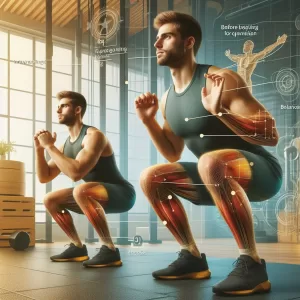
Squats are undoubtedly one of the most effective exercises for sculpting, toning, and strengthening the lower body. They target various muscles, including the quads, hamstrings, glutes, and even core strengthening. To maximize the benefits of this exercise and achieve success with your home squats, follow these in-depth tips and tricks.
1. Understanding Squats:
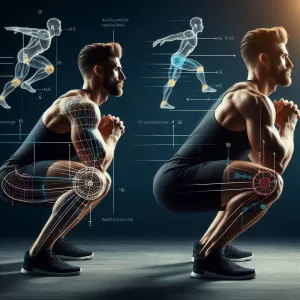
Before diving into technique, it’s crucial to understand why squats are so beneficial. This versatile exercise doesn’t just target multiple muscle groups simultaneously; it also improves your balance, mobility, and endurance. By regularly incorporating squats into your workout routine, you can also reduce the risk of injury by strengthening the muscles around your knees and hips.
2. Perfect Technique for Squats:
– Feet Position: Your feet should be shoulder-width apart, toes slightly pointed outwards. This position ensures maximum stability and reduces pressure on your knees.
– Body Alignment: Keep your back straight with a slight natural curvature in your lower back. Engage your core to support your spine throughout the movement.
– Descent: Imagine yourself sitting on an invisible chair. Lower your body by pushing your butt back and down, making sure your knees do not extend past your toes. Lower yourself until your thighs are parallel to the floor, or as low as you comfortably can.
– The Ascent: Push firmly on your heels to return to the starting position. Engage your glutes at the top of the movement for maximum contraction.
3. Tips and Advice:
– Focus on Form: Before adding weight or aiming for a high number of repetitions, focus on achieving good form. This will maximize the effectiveness of the exercise while minimizing the risk of injury.
– Breathing: Breathe deeply as you go down, and exhale as you stand up. Correct breathing can help you maintain a good rhythm and stabilize your core.
– Progression: Start without weights to get used to the movement. As your strength and technique improves, you can introduce free weights like dumbbells or a kettlebell to increase the intensity.
– Variations: To avoid monotony and continue to challenge your body, incorporate squat variations into your workout, such as sumo squats (with feet wider apart), jump squats for a cardio element, or single-leg squats for a work of balance and unilateral strength.
– Warm-up and Cool-down: Never neglect the importance of warming up before and stretching after your exercises. This prepares your muscles for exercise and helps with recovery, reducing the risk of pain and injury.
By following these tips, you will be able to get the most out of your squats at home, ensuring safe and effective execution. Squats aren’t just a lower body exercise; they are a foundation for overall strength and fitness.
II. Pumps:
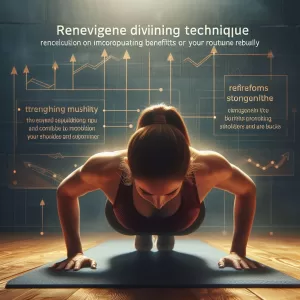
Push-ups are a mainstay of fitness training, known for their ability to build upper body strength without any equipment. This versatile exercise mainly targets the pectorals, shoulders, triceps, and works the core for overall stability. To maximize your results and succeed at home push-ups, follow these step-by-step guidelines, complete with tips and advice.
1. Understanding of Pumps:
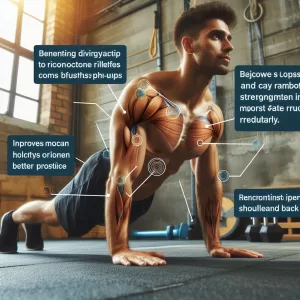
Before diving into technique, recognizing the benefits of push-ups can motivate you to incorporate them into your routine regularly. Beyond strengthening muscles, they improve joint stability and can contribute to better posture by strengthening the muscles around your shoulders and back.
2. Optimal Pump Technique:
– Starting Position: Start in a plank position with your hands placed a little wider than shoulder-width apart. Your feet can be placed closer together to increase difficulty or slightly apart for added stability.
– Body Alignment: Your body should form a straight line from head to toe. Engage your abs and glutes to prevent your hips from sagging or lifting.
– The Descent: Keeping your body rigid, slowly lower yourself by bending your elbows until your chest almost touches the ground. Keep your elbows slightly tilted toward your body to protect your shoulders.
– The Rise: Exhale as you push yourself upwards until your arms are almost straight. Be careful to maintain body alignment without compromising form.
3. Tips and Advice:
– Master Form before Quantity: The quality of repetitions is more important than the number. Focus on perfect execution rather than the number of push-ups.
– Breathing: Inhale on the way down and exhale on the way up. Proper breathing helps control movement and stabilize the trunk.
– Variations for Development: Incorporate different push-up variations (like diamond push-ups, wide push-ups, or elevated push-ups) to target muscles from different angles and avoid training plateaus.
– Using Apps or Programs: Apps and workout programs can offer structured routines to progress your push-ups, ranging from beginner to advanced levels.
– Listen to Your Body: If you feel pain, especially in the shoulders or lower back, review your technique or reduce the intensity. Push-ups should not cause joint pain.
– Adapted Progression: If standard push-ups are too difficult at first, start with push-ups on your knees or against a wall. Gradually, as your strength improves, move on to more difficult versions.
– Regularity and Patience: The key to success with push-ups, as with any exercise, lies in regularity and patience. Improvements in strength and endurance will be felt over time.
Push-ups are an exceptionally adaptable and effective exercise for strengthening your upper body. By following these tips and remaining dedicated to regular practice, you will see significant improvements not only in your ability to perform push-ups but also in your overall strength and body composition.
III. The planks:

Planks are a fundamental strengthening exercise that effectively targets the body’s core, encompassing the abs, back muscles, and even the shoulders and glutes. This static position is known to improve posture, increase stability, and reduce the risk of back pain, in addition to contributing to better performance in other exercises and daily activities. To get the most out of boards at home, here’s detailed information, plus tips and advice.
1. Deep Understanding of planks:
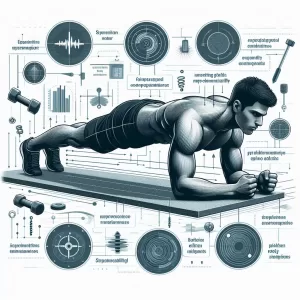
The plank is more than just an abdominal exercise; it is a test of resistance and overall stability. By engaging multiple muscle groups simultaneously, it provides a comprehensive workout that can improve your balance and functionally strengthen your body.
2. Optimal Technique for Planks:
– Starting Position: Lie face down on the ground. Place your forearms on the floor, with elbows aligned under shoulders, and hands either flat on the floor or together.
– Body Activation: Push through your forearms and toes to lift your body off the ground. Engage your abs, and glutes, and squeeze your quads to form a straight line from head to heels.
– Correct Position: Keep your head in line with your spine, avoiding dropping it forward or lifting your chin. Your gaze should be directed towards the ground.
– Duration: Hold the position for as long as possible without compromising your form. Start with short durations and gradually increase.
3. Tips and Advice:
– Quality Over Quantity: It is more beneficial to maintain a perfectly executed plank for a short duration than to hold it longer while sacrificing form.
– Breathing: Do not hold your breath. Breathe in a controlled and even manner to help maintain the position.
– Progression and Variations: Once you are comfortable with the basic plank, introduce variations to continue to challenge your body, such as the side plank, handstand plank, or one-arm raise plank or a leg.
– Daily Routine: Incorporating planks into your daily routine can significantly improve your core strength. Try adding a few sets of planks at different times of the day.
– Use a Mirror: Exercising in front of a mirror can help you correct your posture and ensure your body forms a straight line.
– Pay Attention to Your Body’s Signals: If you feel pain, especially in your lower back, check your technique. Poor form can lead to strain and pain.
– Mental Commitment: The plank is as much a mental challenge as it is physical. Use visualization techniques or listen to music to help you stay focused and hold the position longer.
Planks are an extremely beneficial and versatile exercise, capable of strengthening many aspects of your overall fitness from the comfort of your home.
By following these tips and practicing regularly, you will not only improve your core strength but also enjoy better posture and reduced back pain.
IV. The lunges:
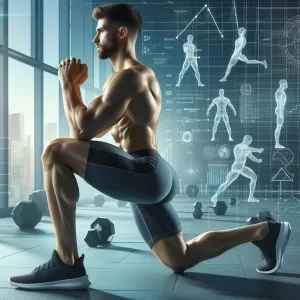
Lunges are a versatile and effective exercise for targeting the lower body, especially the thighs, and glutes, and at the same time, they help improve balance and coordination. They stand out for their ability to work the muscles in isolation, providing a balanced workout and preventing muscle imbalances. Here is a detailed guide with tips to optimize your lunge practice at home.
1. Understand the Importance of Lunges:

Lunges don’t just work the thighs and glutes; they also engage the calves, hamstrings, and core, creating a complete lower body exercise. In addition to strengthening these muscles, lunges help improve hip agility and flexibility, beneficial for a variety of everyday and athletic movements.
2. Basic Technique for Lunges:
– Starting Position: Standing with feet hip-width apart. Keep your upper body straight, with your shoulders back and your gaze focused straight ahead.
– Execution of the Movement: Take a big step forward with one leg, making sure to maintain balance. Lower your body until your front thigh is parallel to the floor and your back knee is almost in contact with it. Your front knee should be in line with your ankle, not pushed forward.
– Return to Initial Position: Push on the heel of your front leg to return to the starting position. Repeat the exercise with the other leg.
3. Tips and Advice:
– Warm-up: Before starting your set of lunges, make sure you do a good warm-up to prepare your muscles and avoid injury.
– Control and Slowness: Perform the movement slowly and with control, avoiding sudden or rapid movements that could cause injury.
– Lunge Depth: Adapt the depth of your lunge to your fitness level and flexibility. Over time, try increasing the depth for more intense muscle work.
– Variations for More Challenge: Introduce variations such as side lunges, walking lunges, or back lunges to diversify your workout and target muscles from different angles.
– Use of Weights: To increase intensity, you can hold dumbbells in each hand or use a backpack with additional weight. Make sure you master the form without weights before adding resistance.
– Stability and Balance: If you have difficulty maintaining balance, focus on a fixed point in front of you. You can also practice next to a wall or chair for extra support.
– Breathing: Breathe in when going down and exhale when returning to the starting position. Proper breathing helps maintain rhythm and stabilize the core.
Lunges are an exceptional exercise for strengthening and toning the lower body while working on balance and coordination. By following these tips and regularly incorporating lunges into your home workout routine, you will develop the strength, endurance, and agility are needed for improved physical performance and a better quality of life.
V. Crunches:

Crunches are a classic and fundamental exercise for strengthening the abdominal muscles. When done correctly, they can effectively target the abdominals without placing unnecessary stress on other parts of the body, such as the back or neck. Here is a detailed guide, enriched with tips and advice, to succeed in your crunches at home and optimize their effectiveness.
1. Understanding of Crunches:
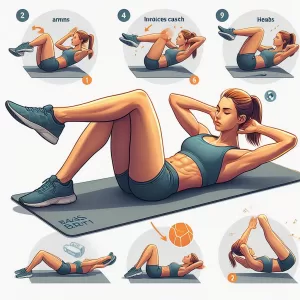
Crunches focus on contracting the abdominal muscles, particularly the rectus abdominis, which is the muscle running along the front of the abdomen. This “crunching” action helps sculpt the abs, contributing to better overall fitness, and better posture, and can help reduce lower back pain by strengthening the body’s central core.
2. Basic Technique for Crunches:
– Starting Position: Lie on your back on a mat with your knees bent and your feet flat on the floor, hip-width apart. Place your hands behind your head or crossed over your chest.
– Execution of the Movement: Contract your abdominals to lift your head, neck, and shoulders off the ground towards your knees. The movement should be slow and controlled, focusing on contracting the abdominals.
– Return to Initial Position: Slowly lower your body to return to the starting position, keeping tension in the abdominal muscles.
3. Tips and Advice:
– Avoid Pulling on your Neck: Keep a fist-sized space between your chin and your chest to avoid pulling on your neck. Imagine holding an orange under your chin.
– Concentration on Breathing: Exhale on the way up and inhale on the way down. Correct breathing increases the effectiveness of the exercise by helping to contract the abdominals more.
– Quality over Quantity: Focus on completing each repetition with perfect form rather than the number of repetitions. Well-performed crunches are more beneficial than many hastily and incorrectly performed crunches.
– Progression and Variations: To continue to challenge your abs and prevent stagnation, incorporate crunch variations like oblique crunches, bicycle crunches, or reverse crunches.
– Warm-up and Stretch: Always start your workout with a warm-up to prepare your muscles for exercise and end with stretching to promote recovery and flexibility.
– Integration into a Balanced Routine: For optimal results, combine crunches with other exercises that target different parts of the body, including cardio and strength exercises, for a balanced approach to fitness.
– Listen to Your Body: If you feel pain, especially in your lower back or neck, review your technique or take a break. Crunches should not cause pain if done correctly.
By following these tips, you can maximize the effectiveness of your at-home crunches, helping to strengthen and sculpt your abs. Remember, consistency and perseverance are key. Significant results in terms of strength and abdominal aesthetics will come with time and commitment to your practice.
Conclusion:
By incorporating these 5 essential exercises into your home fitness routine, you benefit from a comprehensive and diverse workout that stimulates the entire body. Squats strengthen thighs, and glutes and improve lower joint mobility, while push-ups build a strong chest, sturdy shoulders, and sculpted triceps. Planks are invaluable for developing a core of steel, strengthening the back, and improving posture. Lunges dynamically target the leg muscles, promoting balance and coordination, and finally, crunches are crucial for sculpting the abs and strengthening the core.
Together, these exercises offer a holistic approach to fitness, not only improving muscular aesthetics but also promoting general health, mobility, and well-being. No matter where you are in your fitness journey, these key exercises are your foundation for achieving peak fitness at home.

